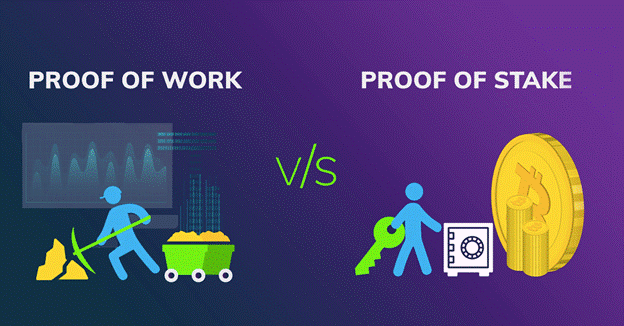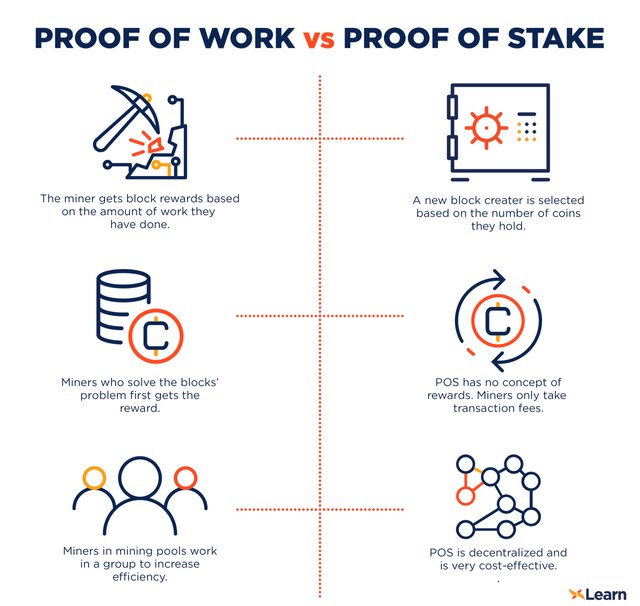 source
source 
What is the difference between PoW & PoS? Advantages & Disadvantages? Which one is better in scaling Capacity? Examples?

What is the difference between PoW & PoS?
A consensus mechanism has to do with various types of methodologies that are used to achieve trust, faith, security and agreement of users across a number of decentralized computer networks by ensuring secure and genuine crypto transactions.
 source
source Consensus enforces the security of a blockchain and both Proof-of-Work (PoW) & Proof-of-Stake (PoS) are consensus mechanisms used as a preventive measure from tampering with the blockchain network and verifying transactions without the need for a third-party system.
Proof-of-Work (PoW) & Proof-of-Stake (PoS) are the most famous consensus mechanisms employed by various cryptocurrencies to attain specific goals.
Proof-of-Work (PoW):
Proof-of-Work (PoW) is the most commonly used consensus algorithm by major cryptocurrencies, it is needed to make these cryptocurrencies function without any government or company controlling them. Proof-of-Work (PoW) was invented by the creator of Bitcoin - Satoshi Nakamoto.
 source
source Proof-of-Work (PoW) is essential because it provides a solution for the "Double-Spend" problem, this is a problem that occurs when the same transaction is sent more than once. This is a big problem in the online world because when you're out in the physical world spending money, you do not make the mistake of spending or giving out that same physical cash to a recipient twice.
But in a digital world, in this context - a crypto space there is a probability of a user spending that same funds twice because digital activities are easy to replicate, so here is where Proof-of-Work (PoW) comes in to ensure that does not happen.
By using a combination of game theory and cryptography, Proof-of-Work (PoW) makes sure that users cannot spend funds that they don't have the authority to spend. Without Proof-of-Work (PoW) then cryptocurrency would be worthless.
Proof-of-Stake (PoS):
Blockchain protects its integrity with the use of methods like the Proof-of-Stake (PoS) consensus mechanism. It is an algorithm that restricts users from minting more coins that they did not earn. It is also a protocol used to add new blocks to a chain and confirm transactions.
With Proof-of-Stake (PoS), the more coins a cryptocurrency miner holds give Him/Her more power to validate block transactions or mine. As an alternative to Proof-of-Work (PoW), Proof-of-Stake (PoS) was invented to address the issue of environmental sustainability and scalability surrounding the Proof-of-Work (PoW) consensus mechanism.
Proof-of-Stake (PoS) makes the network less vulnerable for miners to attack. So to some extent, it is secure. Many coins use the Proof-of-Stake (PoS) protocol and some of these coins include; Algorand (ALGO), Cardano (ADA), Tezos (XTZ), etc.
 source
source 
Advantages & Disadvantages? (of PoW & PoS)
Proof-of-Work (PoW):
| Advantages | Disadvantages |
|---|---|
| It brings about a decentralized method of adding blocks to a chain and verifying transactions. | It uses a high amount of energy. |
| It has maximum security. | Its fees are really expensive and the speed when it comes to processing transactions is slow. |
| It allows miners to earn cryptocurrency rewards. | Expensive equipment is required for mining. |
Proof-of-Stake (PoS):
| Advantages | Disadvantages |
|---|---|
| It doesn't need the utilization of powerful computers or the consumption of a large amount of energy as it is more energy-efficient than Proof-of-Work (PoW). | The technical and technological barriers that come with understanding a blockchain and owning cryptocurrencies can discourage a user from engaging in the platform. |
| It requires lesser hardware and allows more users to take part in the consensus process. | Its validator selection is more complicated and should be protected hold-ups and attacks. |
| Expanding computational resources isn't required because it has energy efficiency. | Since Proof-of-Stake (PoS) is still new and developing, the security is not as high as that of Proof-of-Work (PoW). |
| Authentication of transactions is processed quickly. | Nobody can earn coins to stake when they don't have coins and it is not possible for them a validator. |

Which one is better in scaling Capacity? Examples?
Scalability has to do with a system's capacity to handle an increasing amount of work. It requires more efforts that boost the system to cope with the growing workload. Poor scalability in other words means a system doesn't scale well. In a better Blockchain term, it refers to to the capability of the network to sustain a larger number of occurrences.
Proof-of-Stake (PoS) is better in scaling capacity than Proof-of-work (PoW). Proof-of-work (PoW) mechanism is having a hard time adapting conventional use.
Proof-of-Stake (PoS) offers consistency and speed, it also guarantees various solutions to the bitcoin scalability issues. The main problem of energy consumption and slow speed of transaction that is a regular occurrence in Proof-of-Work (PoW) is tackled and handled by Proof-of-Stake (PoS). Proof-of-Stake (PoS) allows the processing of thousands of transaction requests per second on its network.
You might think Proof-of-Stake (PoS) is complex but if you dig deep into its network and understand them, you will find out that Proof-of-Stake (PoS) is the future and Proof-of-Work (PoW) cannot obtain scalability.
Examples of coins that use Proof-of-Stake (PoS);
- Cosmos (ATOM)
- Tezos (XTZ)
- VeChain (VET)
- Solana (SOL)
- Cardano (ADA)
- Polkadat (DOT)

See how work clean
Nice one bro
Downvoting a post can decrease pending rewards and make it less visible. Common reasons:
Submit
Thank you my guyy
Downvoting a post can decrease pending rewards and make it less visible. Common reasons:
Submit